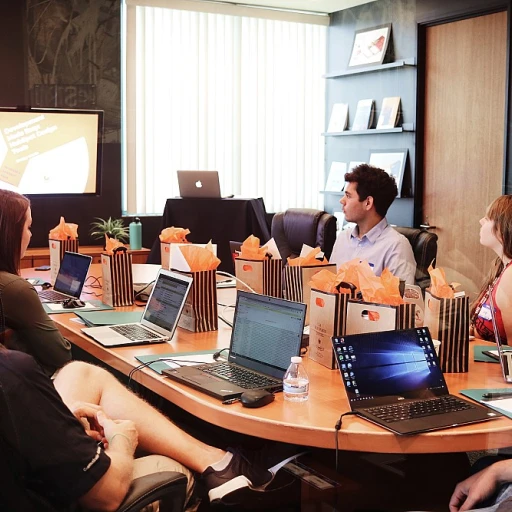
The Complexity of Reskilling
Navigating the Maze of Workforce Upskilling
Reskilling in today's dynamic job market is far from straightforward. The global workforce is facing rapid technological advancements, changing business needs, and evolving employee roles, making it essential to develop a flexible workforce. However, this task is laden with complexity.
Navigating workforce development involves identifying the critical skills gap within an organization. Community colleges and professional development programs often come into play, offering structured learning experiences to bridge this gap. Yet, the task of aligning these training programs with specific job roles and employee development objectives remains challenging. It's crucial for organizations to consider the pros and cons of various training opportunities to ensure they are meeting both business and employee needs.
Moreover, workforce planning requires a deep understanding of labor market trends and employee engagement strategies. Employers must focus on offering job training and employee training that resonates with their employees' interests to increase job satisfaction and long-term commitment. Although continuous learning and development programs can facilitate a productive workforce, organizations often struggle with efficiently managing these endeavors.
For instance, the Arizona Workforce Diploma Program provides a unique model of addressing these complexities by equipping workers with essential skills and credentials tailored to the local labor market. This highlights the importance of targeted initiatives that cater to specific regional workforce needs while promoting personal development.
As we explore further, it's critical to understand that the complexity of reskilling is intertwined with the financial implications, time constraints, and other hurdles organizations face. The success of workforce development programs hinges on a clear strategy that aligns with the specific requirements of the staff, team, and entire company.
Financial Implications
The Financial Costs of Reskilling
Investing in workforce development requires significant financial commitment from companies and employees alike. Organizations must allocate funds to design effective training programs, acquire necessary resources, and sometimes, hire external services to facilitate employee learning. The costs are not limited to development alone but extend to maintaining a flexible workforce in a competitive labor market.
For employers, financial implications include developing comprehensive employee training that ensures staff are equipped to meet the demands of skill gaps. This investment is crucial not only for individual employee development but also to ensure long-term stability and growth for the business. However, these investments can strain budgets, especially in smaller organizations where resources are limited.
From the perspective of employees, engaging in continuous learning and personal development can involve financial burdens. Whether it’s through enrolling in community college programs or seeking professional development opportunities externally, these costs can impact personal finances.
Despite these challenges, the financial commitment to reskilling should be viewed as an investment. For the workforce, upgrading skills can translate into better job satisfaction, more versatile roles, and increased earning potential. On an organizational level, a competent team fueled by targeted training opportunities can drive innovation and enhance employee engagement.
As businesses forge ahead in this competitive landscape, they can enhance their strategies by exploring employer branding as a transformative tool in recruitment and retention. Employers can communicate their commitment to reskilling as part of their brand proposition, attracting top talent who value development.
Time Constraints
Balancing Act: Managing Temporal Barriers in Workforce Reskilling
Time is a crucial element in workforce development, and its constraints pose significant challenges to reskilling efforts. For many organizations, achieving a balance between ongoing work responsibilities and employee training can be daunting. Employees often find themselves caught between delivering their current job roles and engaging in training opportunities to develop new skills.
Companies need to strategize on how to implement flexible workforce training programs that accommodate varying schedules and work commitments. Some employers have successfully integrated job training into their workdays, allowing employees to participate in employee development sessions without the stress of losing productivity. However, it is not always as straightforward.
The pros and cons of different training formats should be considered. Online learning offers flexibility and accessibility, making it easier for companies to train their global workforce. On the other hand, in-person employee training at community colleges or technical institutes might provide more tailored experiences. The choice largely depends on the nature of the skills being taught and the preferences of the workforce.
Moreover, personal and professional development must align with the company’s operational timelines. Organizations need to address these time constraints proactively. For instance, offering condensed workshops or evening classes can be a solution to fit employee schedules better. Businesses must be mindful of the evolving needs of their workforce, to improve job satisfaction while closing the skills gap.
For those seeking more insights into navigating workforce development successfully, the Homebridge Career Pathways Login may provide a strategic approach to balancing these aspects effectively.
Resistance to Change
Navigating Resistance in Workforce Development
Resistance to change is a common hurdle in workforce development initiatives. Many employees are comfortable in their established roles and may view reskilling or job training as a disruption rather than an opportunity for personal development. This mindset can be particularly challenging for organizations aiming to foster a flexible workforce prepared for the future. A significant factor contributing to this resistance is the fear of the unknown. Employees might worry about their ability to learn new skills or adapt to emerging technologies. To combat this, companies need to focus on creating a supportive environment for employee training. This involves clear communication about the benefits of training programs and the long-term advantages they bring to both the individual and the business. Additionally, involving employees in workforce planning can ease their concerns. When workers are part of the decision-making process related to their development, they feel more engaged and valued. Understanding the pros and cons of various training programs allows staff to see the direct impact on their job satisfaction and role within the organization. Moreover, businesses can benefit from tailoring job training to align with the unique needs of their employees. Recognizing that some might thrive in community college courses while others prefer on-the-job training or professional development workshops emphasize the importance of diverse training opportunities. By actively addressing the skills gap through adaptive learning strategies and acknowledging the workforce's concerns, companies can enhance employee engagement and create a robust team ready for the evolving labor market.Mismatch of Skills
Discrepancies Between Acquired and Required Skills
In today's rapidly evolving job market, the mismatch between the skills employees possess and those demanded by businesses is becoming a prevalent issue. As organizations continue to adapt to technological advancements and changes in consumer preferences, the skills required for various roles are in constant flux. For workforce development initiatives to be successful, closing this skills gap is critical. Many companies are investing heavily in employee training and development programs to create a flexible workforce capable of meeting these challenges. However, even with these efforts, workers may find their current skill sets insufficient to meet new job demands, resulting in potential job dissatisfaction and performance issues. Several factors contribute to this skills mismatch:- Rapid Technological Change: Technological advancements can outpace the learning and development cycles within organizations, leaving employees behind.
- Insufficient Training Opportunities: Community colleges and other educational institutions may not provide the necessary resources or programs tailored to current workforce needs.
- Inadequate Workforce Planning: Businesses often struggle to predict future skill requirements, leading to misaligned training programs and roles within the company.
Technological Challenges
Integrating Technology in Workforce Training
In the ever-evolving landscape of workforce development, technological challenges often stand as a formidable barrier in reskilling efforts. As employers and organizations strive to develop new skills among their staff, the integration of technology plays a crucial role. Technology not only supports training programs but also aids in efficient workforce planning by streamlining processes and offering innovative solutions for employee development.
However, the challenge is ensuring that both the workforce and the business are technologically ready. Many traditional job training programs have yet to fully adapt to digital advancements, and this can create a disconnect between training opportunities and job requirements.
Organizations must invest in bringing technology to the forefront of employee training. This includes utilizing digital learning platforms and tools that promote flexibility and accessibility for both employers and employees. Such platforms can facilitate continuous learning, which is crucial for bridging the skills gap and enhancing job satisfaction.
Despite these advancements, some workers may resist technological change. Addressing this resistance requires a focus on employee engagement and the comprehensive inclusion of technology in personal development plans. Encouraging staff to embrace technological tools can be made more achievable by providing clear pros and cons of adoption, fostering a more informed and enthusiastic team.
Moreover, integrating technology aligns with global workforce trends, enabling companies to remain competitive in the labor market. Community colleges, for instance, have successfully incorporated tech-based teaching methods, serving as models for effective reskilling initiatives. In this context, ongoing innovation should be a focal point in training employees to equip them with the necessary skills for long-term success.













